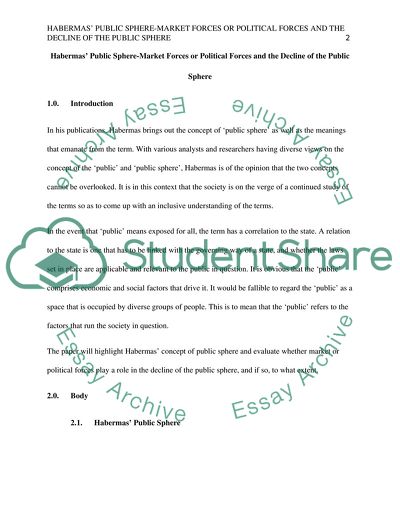Cite this document
(Habermas Public Sphere-Market Forces and the Decline of the Public Sphere Report Example | Topics and Well Written Essays - 2000 words, n.d.)
Habermas Public Sphere-Market Forces and the Decline of the Public Sphere Report Example | Topics and Well Written Essays - 2000 words. https://studentshare.org/journalism-communication/1787495-explain-habermas-public-sphere-and-discuss-whether-market-forces-or-political-forces-have-most-contributed-to-the-decline-of-the-public-sphere-make-specific-reference-to-relevant-academic-literature-from-this-module-guide-and-limit-your-time-period
Habermas Public Sphere-Market Forces and the Decline of the Public Sphere Report Example | Topics and Well Written Essays - 2000 words. https://studentshare.org/journalism-communication/1787495-explain-habermas-public-sphere-and-discuss-whether-market-forces-or-political-forces-have-most-contributed-to-the-decline-of-the-public-sphere-make-specific-reference-to-relevant-academic-literature-from-this-module-guide-and-limit-your-time-period
(Habermas Public Sphere-Market Forces and the Decline of the Public Sphere Report Example | Topics and Well Written Essays - 2000 Words)
Habermas Public Sphere-Market Forces and the Decline of the Public Sphere Report Example | Topics and Well Written Essays - 2000 Words. https://studentshare.org/journalism-communication/1787495-explain-habermas-public-sphere-and-discuss-whether-market-forces-or-political-forces-have-most-contributed-to-the-decline-of-the-public-sphere-make-specific-reference-to-relevant-academic-literature-from-this-module-guide-and-limit-your-time-period.
Habermas Public Sphere-Market Forces and the Decline of the Public Sphere Report Example | Topics and Well Written Essays - 2000 Words. https://studentshare.org/journalism-communication/1787495-explain-habermas-public-sphere-and-discuss-whether-market-forces-or-political-forces-have-most-contributed-to-the-decline-of-the-public-sphere-make-specific-reference-to-relevant-academic-literature-from-this-module-guide-and-limit-your-time-period.
“Habermas Public Sphere-Market Forces and the Decline of the Public Sphere Report Example | Topics and Well Written Essays - 2000 Words”. https://studentshare.org/journalism-communication/1787495-explain-habermas-public-sphere-and-discuss-whether-market-forces-or-political-forces-have-most-contributed-to-the-decline-of-the-public-sphere-make-specific-reference-to-relevant-academic-literature-from-this-module-guide-and-limit-your-time-period.


